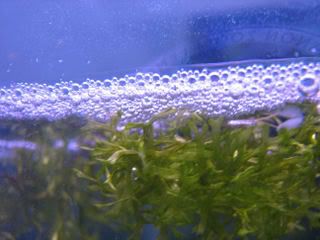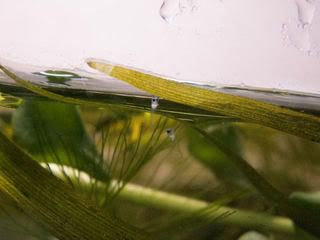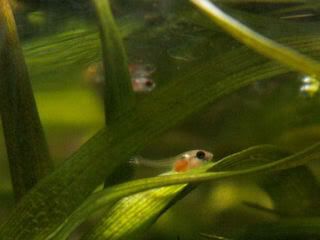Breeding Betta Splendens (The Siamese fighting fish)
I use a standard 40 litre aquarium with a reasonably tight fitting cover so as to keep the air above the water warm and moist. Although in our summer seasons this does not pose any problems as temperatures may reach 32 degrees. This helps the male with his bubble nest maintenance. Depending on the time of the year (in summer best time for breeding as temperature is ideal), I heat the water with a submersible 50 watt heater to 26 - 28 degrees. This seems to be the optimal breeding temperature. I had no problem with particular water chemistry as our tap water has a Ph of 7.5 although it is suggested that slightly acidic to slightly alkaline and moderately soft seem to be optimal.
The tank half full with 10 litres of treated tap water and another 10 litres from a healthy existing aquarium or a sponge filter from an already established aquarium. Though, in most cases I rarely use any filtration system during the first few weeks. Also one must keep in mind that any water movement will disturb the bubblenest and makes breeding difficult and frustrating at the same time. So, if anyone is going to use any sponges I suggest to use some sort of valve to control the output to minimize disturbance.
Aquarium Set-up
It is important to have some sort of material which is able to float and at the same time offers some protection to the bubble-nest. I use a Styrofoam coffee cup which I cut in half - lengthwise. Float this in the water cut side down. It will serve as a location for the male to build his nest under it. Use a new kerosene lamp glass chimney placed in the tank to keep the female separated from the male. When releasing the female, lift the glass chimney straight up slowly. You will find this does not disturb the water surface or bubble nest. Put a portion of java moss or other plants in the tank which will serve as a refuge for the female during courtship (an on occasions even for the male as I had a number of females which attacked the male so viciously that they tore all fins and died from wounds). The java moss helps to grow infusoria which are microscopic organisms that are essential for the newly hatched Betta fry that will feed on. Lately, I used Indian Almond leaves which must be dry enough to float and after a week or two they gently sink at the bottom and help to increase infusoria and is ideal for the first few days as food for the fry.
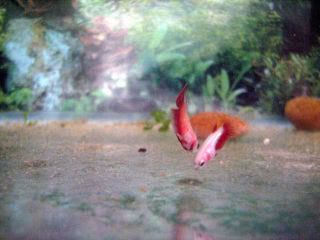
Introducing the pair
In my method, the male is in the tank while the female is placed in the glass chimney at the same time. This helps to eliminate any territorial behaviour being developed and decreases aggressiveness. It is best to keep them apart for 24 hours and hopefully during this time the male will busy himself in building a bubble nest. The colour and finnage in each is at its best as the courtship begins. It is important to note that a lot of energy will be used by both fish and thus healthy specimen must be used. It is best to have a female and a male of the same size and age as this would give them the best chance to survive the ordeal. Conditioning the fish is a must and diet must consist of high protein foods. I tend to feed them twice a day with blood worms for a week or so before the breeding experiment.
After the lapse of 24 hours the female is released notwithstanding the fact that the male has managed to build the bubble-nest or not. The male will entice the female by displaying and swimming towards the bubble-nest. It is at this stage of the breeding behaviour that biting and chasing of the female occurs. A certain amount of abusive damage to her is a normal part of the courtship. She will retreat and hide and this is why it is important to have enough space and hideouts. This chase goes on for one to two days prior to a spawning attempt. The female would take occasional breaks by hiding from the male and once it shows interest, the female will be attacked again.
Female readiness to spawn
The female will show certain signs that she is ready to spawn and on dark fish, she will have a vertical barred pattern and the ovipositor or \"egg spot\", will be pronounced. She will have a plump appearance from eggs in the belly region. By the end of the third day if there are no signs of any spawning it is time to remove the female and isolate them and treat for any injuries that they might have sustained. During this period of isolation I will start feeding them any live foods or frozen for another week or so to re-condition them. After such period repeat the above procedure for breeding. It has been suggested by other experienced breeders that waiting for a low-pressure weather pattern or keeping the fish in darkness for a week or two are also spawning triggers.
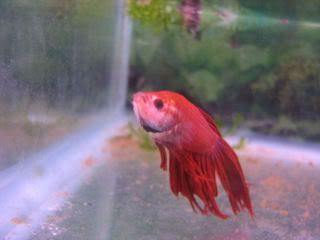
Should the courtship proceed to a spawn, the female will assume a head down, clamped finned posture to signal the male her intent. He will respond by wagging his body in an \"S\" pattern, head up. Spawning embrace attempts ensue. If it is the pairs first time, the embraces will be awkward and seemingly laboured. The male may even become frustrated and drive the female off. Let the fish try and work it out. Sometimes it is the male that gets attacked by a frustrated female! Through all this, keep a watchful eye that neither fish is suffering so much abuse that it leads to death. Although this can occur, it is the exception of a spawn attempt outcome. Expect a lot of abuse, male to female.
With each embrace, eggs will begin to flow and since fertilization is external, the male simultaneously expels milt (the semen and seminal fluid of a fish). Each fish vent is in proximity and the male will wrap himself around the female topside she will roll upside down. After the release of eggs, the fish will seem \"stunned\" and tired from this ordeal. The male will start collecting the eggs in his mouth as they sink and place them in the bubble-nest. The female floats to the surface on her side and when she \"comes to\" will either help collect, ignore, or eat the eggs. It is important to keep enough light for the male to be able to see the eggs and pick them in his mouth and spits them into the bubble-nest. Another issue to keep in mind is that the tank should be bare in that no gravel is used. If it is bare, the male will be able to see the eggs and picks them up with his mouth and spits them into the bubble-nest.
Once this is observed, it will be a sign to remove the female and to treat her from any injuries sustained. She will not be ready to spawn for another three weeks and so a good rest must ensue after such breeding experience. In certain occasions it is much better to have a smaller spawn for a successful hatch. During this stage hundreds of eggs may be produced but many will be unfertilized. It is advisable to remove the female carefully and try not to disturb the bubble nest as much as possible. Try to corner her without stressing her too much to remove her gently without disturbing the male.
During the first embraces there is no release of eggs from the female and then a few might be released. During the peak, eggs may \"rain down\" and only during the end that the count will taper off toward the end. This behaviour or spawning can last up to several hours. When the spawning is over there are some important visible signs to note as the male will drive off the female. It is at this stage that one must keep an eye on the female and remove her from the tank as she will be subjected to more beatings. In rare cases, females will show similar behaviour to that of males in that they start picking up eggs and spit them back into the bubblenest. But as a recommendation, if this is the first time for all, I would not suggest to leave the female in the tank.
Feeding Fry
The male will tend the eggs in the nest and they should hatch in 36 hours and this is why one must have optimal temperatures. Too much heat will cause the eggs to hatch prematurely and lead to defects and weak brood with the result of too many deaths. The male will continue during this period to pick up any fry that would have fallen from the bubble-nest.
The hatchlings (fry) would not be able to swim well, as they will be absorbing their egg sac. I start off feeding them microworms during the first week or two. After that I start feeding them freshly hatched brine shrimp which is ideal for a healthy growth. You will know that they are eating brine shrimp as their bellies would turn orange.
In another 36 to 48 hours, the fry will be free swimming and on the look out for food as their egg-sac would have been completely absorbed. Usually I will remove the male when I see the first free-swimming fry. But to play it safe I remove him a bit earlier to avoid seeing the fry as a new form of live food.



